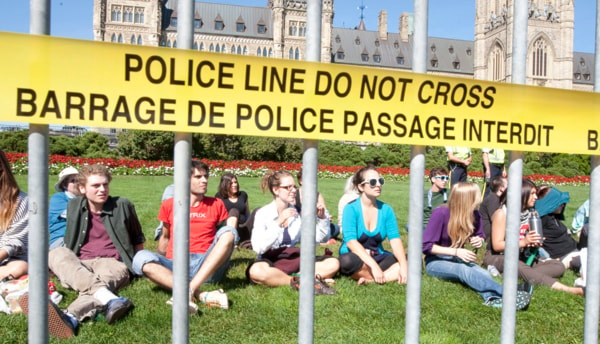OTTAWA — As protests go, it was the antithesis of the G20 in Toronto.
Several hundred people showed up on Parliament Hill on Monday to protest the Keystone XL pipeline and the expansion of the oilsands.
But unlike last summer’s demonstrations in Toronto, where destruction and violent confrontation were the order of the day, this event was downright sedate.
“It’s a peaceful and serious tone that we created on the Hill here today, and a peaceful and serious message regarding the impacts that the tarsands are having, that we’re seeking to deliver to the prime minister,” said Greenpeace organizer Mike Hudema.
After an hour or so of speeches, more than 100 of the protesters organized themselves in small groups and gingerly climbed over a police barricade in front of the Peace Tower.
After each one had some quiet words with one of the dozens of police officers waiting for them, they sat down in straight rows in the sunshine, waiting to be processed.
The first wave was detained without incident, taken away in plastic handcuffs to a tent behind the Parliament buildings. They were then released about 90 minutes later. They were fined $65 for trespassing and told to keep off Parliament Hill for a year.
The rest of the protesters — many of them with bail money in their pocket, just in case — expected similar treatment. At one point, police went to escort some protesters into the queue, but stopped when they saw the protesters were helping a man in a wheelchair climb over the barriers.
Among the first to be cuffed with plastic ties were Dave Coles, president of the Communications, Energy and Paperworkers Union and veteran activist Maude Barlow.
The demonstration was organized by Greenpeace and other groups who say the 2,700-kilometre pipeline from Alberta to Texas is harmful to the environment in both Canada and the United States.
The demonstration was inspired by two weeks of protests at the White House in August, where more than 1,000 people were arrested, including movie star Daryl Hannah.
The Canadian version claimed celebrity support as well, although there were no household names among those who were actually detained.
Despite the lack of ruckus, politicians seemed to take note. Even before the demonstration began, Prime Minister Stephen Harper and Natural Resources Minister Joe Oliver were pushing back, defending the oilsands and the pipeline as beneficial for the Canadian economy.
“Our government will continue to promote Canada, and the oil sands, as a stable and secure source of energy to the world, and will defend Canadian jobs and interests,” Oliver said in a news release issued during the demonstration.
He said the pipeline would create more than 140,000 jobs in Canada in the next 25 years, and generate $600 billion in economic activity. His officials did not immediately explain how those numbers were reached.
Immigration Minister Jason Kenney was far more blunt.
“Sad 2 see about 200 extremists on the Hill today who want to kill livelihood of hundreds of thousands of Cdns,” Kenney tweeted.
